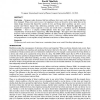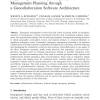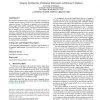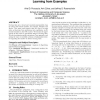648 search results - page 68 / 130 » Collaborative Modeling - A Design Science Approach |
IJHCI
2010
13 years 9 months ago
2010
Motivation – Designers make decisions that later influence how users work with the systems that they have designed. When errors occur in use, it is tempting to focus on the acti...
CAD
2002
Springer
13 years 10 months ago
2002
Springer
Current modelling systems adequately support either modelling of parts or modelling of assemblies, whereas ideal modelling systems should adequately support both. To achieve this,...
CSCW
2007
ACM
13 years 11 months ago
2007
ACM
Emergency management is more than just events occurring within an emergency situation. It encompasses a variety of persistent activities such as planning, training, assessment, and...
SIGECOM
2006
ACM
14 years 5 months ago
2006
ACM
Our proposed methods employ learning and search techniques to estimate outcome features of interest as a function of mechanism parameter settings. We illustrate our approach with ...
ATAL
2008
Springer
14 years 29 days ago
2008
Springer
Scoring rules are a broad and concisely-representable class of voting rules which includes, for example, Plurality and Borda. Our main result asserts that the class of scoring rul...




